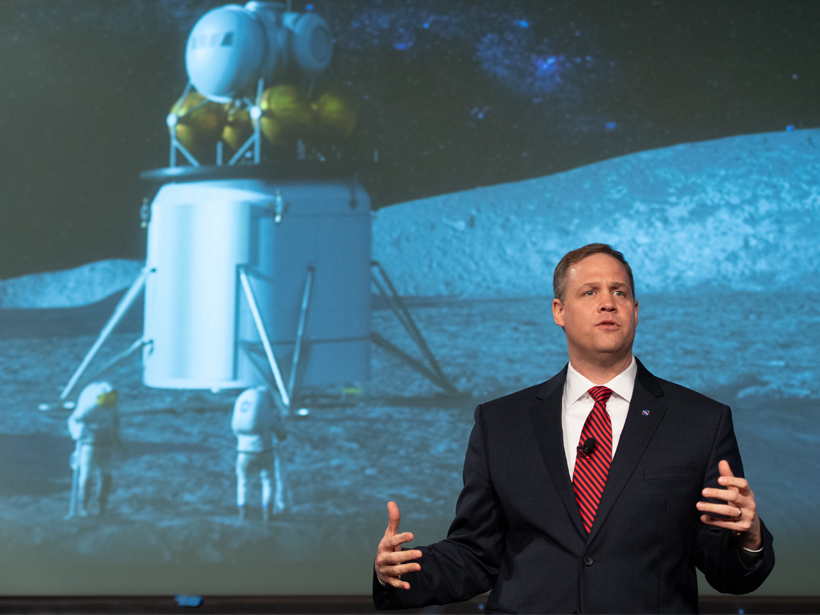NASA administrator Jim Bridenstine wants to get U.S. spacecraft and astronauts back to the Moon soon.
“What we are trying to accomplish is really a balance between getting to the Moon as fast as possible and also making sure that when we get to the Moon it’s sustainable.”
“Right now, what we are trying to accomplish is really a balance between getting to the Moon as fast as possible and also making sure that when we get to the Moon it’s sustainable,” Bridenstine said at a media roundtable Thursday at NASA headquarters in Washington, D.C., to discuss the design and development of reusable and open architecture to return to the Moon.
The next chapter in U.S. lunar exploration will be different, he said. “This time when we go to the Moon, we’re actually going to stay,” he said at the roundtable that preceded an industry forum on the topic. “We’re not going to leave flags and footprints and then come home to not go back for another 50 years.” The Apollo 17 mission, which took place close to 50 years ago in December 1972, was NASA’s last crewed mission to the Moon.
The architecture to return to the Moon should allow NASA to “go back and forth over and over again and not just to one or two parts of the Moon but to all parts of the Moon with landers and rovers, robots, and even humans,” he said.
Developing the Architecture
The agency published a solicitation on 7 February inviting U.S. companies to submit proposals to partner with NASA on designing and developing reusable lunar human landing systems (HLSs). Those proposals are due by 25 March, and NASA currently plans to make initial partnership selections in May. NASA is planning for the launch of the first HLS element demonstration mission in 2024 and for having astronauts land on the Moon in 2028.
The system for sending astronauts will require “three separate elements that will provide transfer, landing, and safe return,” according to a 7 February NASA press release related to the solicitation. “A key aspect of this proposed approach is to use the Gateway”—a planned lunar-orbiting spacecraft—“for roundtrip journeys to and from the surface of the Moon.”
Why So Fast?
“We have already seen the immense amount of international interest there is in the Moon,” Bridenstine said. “Of course, it’s in our interest to make sure that we are represented there as well, as soon as possible.”
Space Policy Directive 1, which President Donald Trump issued on 11 December 2017, calls for the United States to “lead the return of humans to the Moon for long-term exploration and utilization, followed by human missions to Mars and other destinations.”
The push to get back to the Moon fast also comes from his own background, Bridenstine said. “It’s in response to me [formerly] being a member of Congress, and wanting to see more speed out of NASA long before I came to the agency,” he quipped. “But you know what’s happened here? We have a new direction and that new direction is to get to the Moon. That’s part of the president’s Space Policy Directive 1, and we’re trying to make that happen as soon as possible.”
It’s in the nation’s interest to return to the Moon, Bridenstine added. “We have already seen the immense amount of international interest there is in the Moon. And we have seen an immense amount of international interest in specific parts of the Moon, because it could be advantageous from a geostrategic perspective,” he said. “Of course, it’s in our interest to make sure that we are represented there as well, as soon as possible.”
International Partnerships
Bridenstine added that not only does NASA intend to go to the Moon “back and forth regularly with humans” but that “we want to take all of our international partners and have them be part of this effort to get to the Moon.”
However, Bridenstine drew the line at China being a partner in the effort. “As far as partnering with China, of course, we are prohibited from doing bilateral cooperation by law,” he said, referring to legislation known as the Wolf Amendment after former Rep. Frank Wolf, which bans almost all bilateral U.S.-China space cooperation.
“We are doing very, very well. You know, somebody lands on the far side of the Moon and NASA lands on the far side of Mars.”
“Certainly, I’m not going to do anything that would violate the law. To the extent that we had multilateral cooperation, of course, it would be done through the interagency process, and it would be done in consultation with Congress as well,” he said. “So, I’m not going to close that door, but certainly, it’s not a door that I’m opening wide up.”
Is the U.S. Falling Behind?
Bridenstine added that the United States is doing great in space exploration.
“I’ve seen media reports saying that the United States of America is falling behind. That is not the case when it comes to exploration,” he said. “We are doing very, very well. You know, somebody lands on the far side of the Moon and NASA lands on the far side of Mars.”
—Randy Showstack (@RandyShowstack), Staff Writer
Citation:
Showstack, R. (2019), NASA wants to get back to the Moon, and fast, Eos, 100, https://doi.org/10.1029/2019EO116493. Published on 15 February 2019.
Text © 2019. AGU. CC BY-NC-ND 3.0
Except where otherwise noted, images are subject to copyright. Any reuse without express permission from the copyright owner is prohibited.
Text © 2019. AGU. CC BY-NC-ND 3.0
Except where otherwise noted, images are subject to copyright. Any reuse without express permission from the copyright owner is prohibited.

